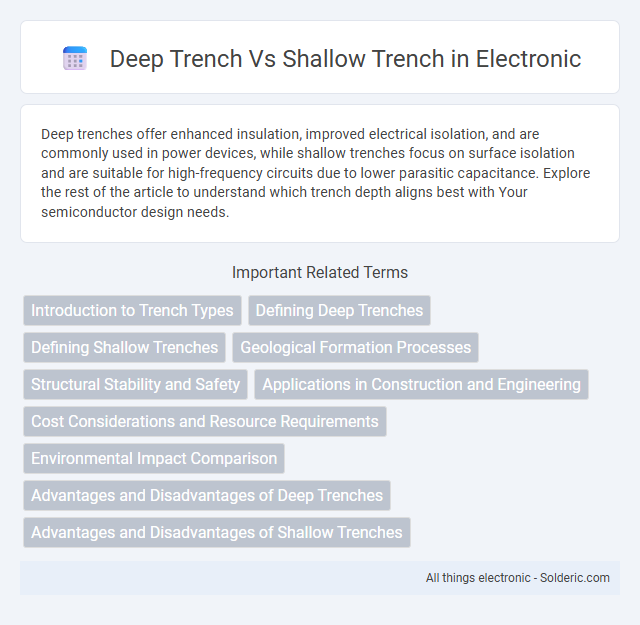Deep trenches offer enhanced insulation, improved electrical isolation, and are commonly used in power devices, while shallow trenches focus on surface isolation and are suitable for high-frequency circuits due to lower parasitic capacitance. Explore the rest of the article to understand which trench depth aligns best with Your semiconductor design needs.
Comparison Table
| Feature | Deep Trench | Shallow Trench |
|---|---|---|
| Depth | Typically > 10 um | Typically < 5 um |
| Application | Power devices, high voltage isolation | Microelectronics, surface isolation |
| Fabrication Complexity | Higher due to depth and profile control | Lower, simpler etching processes |
| Etching Method | Deep Reactive Ion Etching (DRIE) | Standard Reactive Ion Etching (RIE) |
| Aspect Ratio | High aspect ratio trenches | Low aspect ratio trenches |
| Isolation Effectiveness | Excellent electrical isolation in power devices | Moderate isolation for integrated circuits |
| Cost | Higher due to complex processing | Lower cost, faster processing |
Introduction to Trench Types
Deep trenches, typically over 10 meters in depth, provide significant structural support and are used for large-scale infrastructure projects requiring stable excavation walls. Shallow trenches, usually less than 2 meters deep, are common in utility installations and smaller construction tasks due to their ease of access and lower excavation costs. The choice between deep and shallow trench types depends on soil conditions, load requirements, and project specifications to ensure safety and efficiency.
Defining Deep Trenches
Deep trenches are geological formations characterized by significant depth, often exceeding several thousand meters, such as the Mariana Trench reaching depths of over 10,900 meters. These trenches form at convergent plate boundaries where one tectonic plate subducts beneath another, creating steep, narrow depressions on the ocean floor. Understanding the distinct depth and tectonic activity of deep trenches helps differentiate them from shallow trenches, which are relatively less profound and form in different geological contexts.
Defining Shallow Trenches
Shallow trenches are narrow, excavated channels typically less than 10 meters deep, used in construction and geotechnical applications to manage drainage, utilities, or foundation support. Unlike deep trenches, which can exceed 20 meters and require extensive shoring and safety measures, shallow trenches offer easier access and faster completion times. Their limited depth reduces risks associated with soil stability and groundwater intrusion, making them suitable for smaller-scale infrastructure projects.
Geological Formation Processes
Deep trenches form primarily through subduction zone processes where one tectonic plate is forced beneath another, creating profound, narrow depressions along convergent plate boundaries. Shallow trenches generally arise from less intense tectonic activity, such as minor plate bending or faulting in the Earth's crust, resulting in less pronounced depressions. The depth difference between deep and shallow trenches reflects variations in tectonic plate interactions, sediment deposition, and crustal deformation during geological formation.
Structural Stability and Safety
Deep trenches offer enhanced structural stability due to their ability to accommodate subsurface support systems such as reinforced shoring and slurry walls, minimizing soil collapse risks. Shallow trenches, while easier to construct, often require additional safety measures like benching or trench boxes to prevent cave-ins, especially in unstable soil conditions. Engineering assessments prioritize deep trenches for projects demanding long-term safety and durability, whereas shallow trenches are preferred for short-term tasks with lower risk profiles.
Applications in Construction and Engineering
Deep trench construction is utilized for installing large-scale infrastructure such as water mains, sewer lines, and utility conduits, providing robust support and facilitating maintenance access in urban engineering projects. Shallow trenches, commonly applied in landscaping, irrigation, and small-scale electrical wiring, enable quicker installation and lower excavation costs while minimizing soil disruption. Both trench types require careful consideration of load-bearing capacity, soil type, and environmental impact to ensure structural stability and long-term performance in construction applications.
Cost Considerations and Resource Requirements
Deep trench excavation demands higher costs due to extensive labor, specialized equipment, and safety measures required for greater depth and stability control. Shallow trenching generally incurs lower expenses with faster completion times and less intensive resource allocation. Your project budget can significantly benefit from choosing shallow trenches unless subsurface conditions or design specifications necessitate deep trenching.
Environmental Impact Comparison
Deep trenches result in greater habitat disruption and increased sediment displacement compared to shallow trenches, potentially altering local ecosystems more significantly. Shallow trenches tend to minimize soil disturbance and reduce the risk of groundwater contamination, thus presenting a lower environmental footprint. Assessing your project's location and environmental sensitivity is crucial for choosing the appropriate trench depth to balance construction needs with ecological preservation.
Advantages and Disadvantages of Deep Trenches
Deep trenches offer enhanced insulation and isolation in semiconductor devices, reducing parasitic capacitance and improving performance in high-density integrated circuits. However, their fabrication requires complex etching techniques and increases production costs, potentially leading to defects or reliability issues. Understanding these trade-offs helps you select the optimal trench depth for balancing device efficiency and manufacturing feasibility.
Advantages and Disadvantages of Shallow Trenches
Shallow trenches provide easier excavation and lower construction costs compared to deep trenches, making them ideal for projects with budget or time constraints. They pose fewer safety risks and reduce the need for extensive shoring or dewatering, which lowers labor and equipment expenses. However, shallow trenches may offer less protection against environmental factors and limited capacity for deep utility installations, which could affect the long-term durability of your infrastructure.
Deep trench vs Shallow trench Infographic

 solderic.com
solderic.com